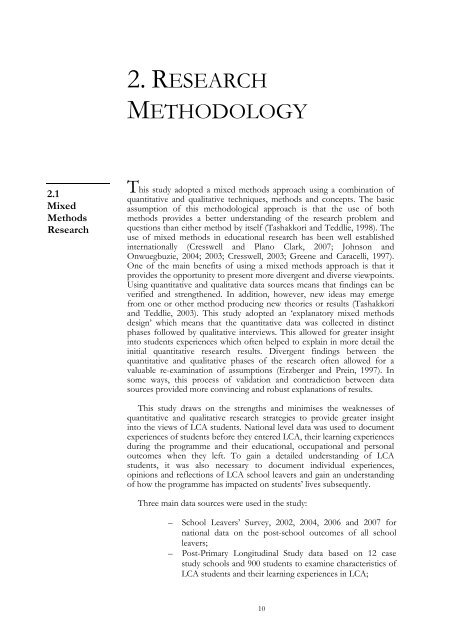Student Experiences of the Leaving Certificate Applied Programme
Student Experiences of the Leaving Certificate Applied Programme
Student Experiences of the Leaving Certificate Applied Programme
Create successful ePaper yourself
Turn your PDF publications into a flip-book with our unique Google optimized e-Paper software.
2. RESEARCHMETHODOLOGY2.1MixedMethodsResearchThis study adopted a mixed methods approach using a combination <strong>of</strong>quantitative and qualitative techniques, methods and concepts. The basicassumption <strong>of</strong> this methodological approach is that <strong>the</strong> use <strong>of</strong> bothmethods provides a better understanding <strong>of</strong> <strong>the</strong> research problem andquestions than ei<strong>the</strong>r method by itself (Tashakkori and Teddlie, 1998). Theuse <strong>of</strong> mixed methods in educational research has been well establishedinternationally (Cresswell and Plano Clark, 2007; Johnson andOnwuegbuzie, 2004; 2003; Cresswell, 2003; Greene and Caracelli, 1997).One <strong>of</strong> <strong>the</strong> main benefits <strong>of</strong> using a mixed methods approach is that itprovides <strong>the</strong> opportunity to present more divergent and diverse viewpoints.Using quantitative and qualitative data sources means that findings can beverified and streng<strong>the</strong>ned. In addition, however, new ideas may emergefrom one or o<strong>the</strong>r method producing new <strong>the</strong>ories or results (Tashakkoriand Teddlie, 2003). This study adopted an ‘explanatory mixed methodsdesign’ which means that <strong>the</strong> quantitative data was collected in distinctphases followed by qualitative interviews. This allowed for greater insightinto students experiences which <strong>of</strong>ten helped to explain in more detail <strong>the</strong>initial quantitative research results. Divergent findings between <strong>the</strong>quantitative and qualitative phases <strong>of</strong> <strong>the</strong> research <strong>of</strong>ten allowed for avaluable re-examination <strong>of</strong> assumptions (Erzberger and Prein, 1997). Insome ways, this process <strong>of</strong> validation and contradiction between datasources provided more convincing and robust explanations <strong>of</strong> results.This study draws on <strong>the</strong> strengths and minimises <strong>the</strong> weaknesses <strong>of</strong>quantitative and qualitative research strategies to provide greater insightinto <strong>the</strong> views <strong>of</strong> LCA students. National level data was used to documentexperiences <strong>of</strong> students before <strong>the</strong>y entered LCA, <strong>the</strong>ir learning experiencesduring <strong>the</strong> programme and <strong>the</strong>ir educational, occupational and personaloutcomes when <strong>the</strong>y left. To gain a detailed understanding <strong>of</strong> LCAstudents, it was also necessary to document individual experiences,opinions and reflections <strong>of</strong> LCA school leavers and gain an understanding<strong>of</strong> how <strong>the</strong> programme has impacted on students’ lives subsequently.Three main data sources were used in <strong>the</strong> study:– School Leavers’ Survey, 2002, 2004, 2006 and 2007 fornational data on <strong>the</strong> post-school outcomes <strong>of</strong> all schoolleavers;– Post-Primary Longitudinal Study data based on 12 casestudy schools and 900 students to examine characteristics <strong>of</strong>LCA students and <strong>the</strong>ir learning experiences in LCA;10

















